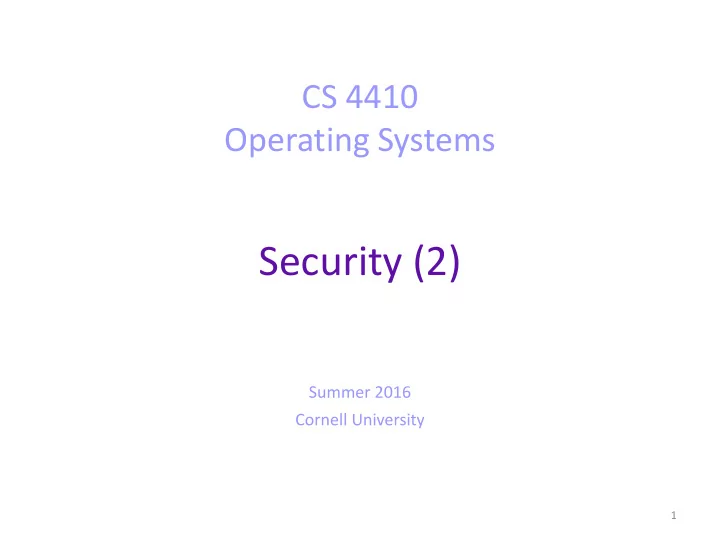

CS 4410 Operating Systems Security (2) Summer 2016 Cornell University 1
Today • Access control • DAC • MAC 2
Access control • Confidentiality and integrity are often enforced using access control. – Predefined operations are the sole means by which principals access information. – A reference monitor is consulted whenever one of these predefined operations is invoked. – The operation is allowed only if the invoker holds the required privileges. 3
Discretionary Access Control (DAC) • In a DAC policy, the owner of an object controls the assignment of privileges for this objects to principals. • DAC policies are what commercial operating systems typically enforce. • The assignment of privileges by a DAC policy can be depicted using a table Auth that has a row for each principal and a column for each object. 4
Auth Objects notes.txt beach.img sort.py Principals Ann r,w r r Beth r r,w George r r • Any DAC policy can be circumvented if principals are permitted to make arbitrary changes to Auth. – Yet as execution of a system proceeds, changes to Auth will inevitably be needed. 5
Protection Domains • Having users as the set of principals is too coarse- grained. • Principle of Least Privilege: the set of operations a principal should be authorized to execute depends on the task to be performed. • Use protection domains as the set of principals, instead. • Each protection domain is associated with a different set of privileges. 6
Protection Domains Objects notes.txt beach.img sort.py Ann@edit r,w r Ann@view r Domains Beth@edit r,w Beth@view r George@edit r r George@view 7
Protection Domains • Allow transitions from one protection domain to another as execution of a thread proceeds. • Different sets of privileges can now be associated with a thread as it progresses from one task to the next. • In an operating system, system calls may cause protection-domain transitions. – Example: change from user mode to kernel mode. 8
Implementing DAC • Auth is sparse. So, implementing Auth as an array is not efficient. • Need data structures that store only the non-empty cells of Auth. • Two approaches: – An access control list encodes the non-empty cells associated with a column (object). – A list of capabilities encode the non-empty cells associated with a row (principal). • Access control lists and capabilities can, in theory, express the same policies. • In practice, they differ in the cost of performing revocation and review . 9
Access Control Lists • The access control list for an object O is a list <P1; Privileges1> <P2; Privileges2> … <PN; PrivilegesN> • Operating system abstractions (e.g., files, sockets, locks) can be protected with access control lists. • System calls are then the only way to access an operating system abstraction. – A reference monitor is embedded in the operating system routine that handles a system call. • Large operating system abstractions (e.g., files) can store their own access control lists. • For small operating system abstractions (e.g., locks or ports), the operating system's memory can be used to store the access control lists. 10
Capabilities • A capability is a pair <O; Privileges>. • Any principal that holds this capability is granted Privileges for operations on O. • Assumption: Capabilities cannot be counterfeited or corrupted. • An authorized principal P can: – create a new object and receive a capability for that object, – transfer to other principals one or more capabilities P holds, and – revoke capabilities that derive from capabilities P holds. 11
DAC in Unix: Accessing a file • Authorization to access a file is partitioned into – a potentially expensive check, which is done infrequently, – and cheaper checks, which are performed for each file access. • The expensive check is moved into an additional system call. – This open system call for a file must be executed prior to attempting read or write system calls on that file. – The access control list of the file specifies if the open system call is successful. • The constraint that open be executed first is enforced because read and write require a file handle argument. • A file handle can be considered as a capability. • Subsequent read and write systems call use this file handle to access the file. • The hybrid of access control lists and capability-like authorization is not a panacea. • Its latency for revocations can be unbounded, because the access control list is not rechecked each time read and write execute. 12
Mandatory Access Control (MAC) • With DAC, the owner specifies allowed operation on the object. • The goals of an institution, however, might not align with those of any individual. • So rules set by the institution are the more natural basis for authorization. • MAC: the institution specifies rules for authorization. 13
Mandatory Access Control (MAC) • A classification L(D) is assigned to each document D. • A clearance L(U) is assigned to each person U. • L maps to a set of labels . – Example: Top Secret (TS), Secret (S), Confidential (C), Unclassified (U). – The institution decides L(D) and L(U). • Confidentiality Policy . A person U is permitted to see a document D only if L(D) ≤ L(U) holds, – where: U ≤ C ≤ S ≤ TS. 14
MAC: Confidentiality • Program Invocation . L(Pgm ) ≤ L(U) must hold for a program Pgm executing on behalf of a user U. • Read Restriction . L(F) ≤ L( Pgm) must hold for program Pgm to read a file F. • Write Restriction . L(Pgm ) ≤ L(F) must to hold for a program Pgm to write into a file F. 15
Today • Access control • DAC • MAC 16
Coming up… • Next lecture: Review • Student evaluation 17
Recommend
More recommend